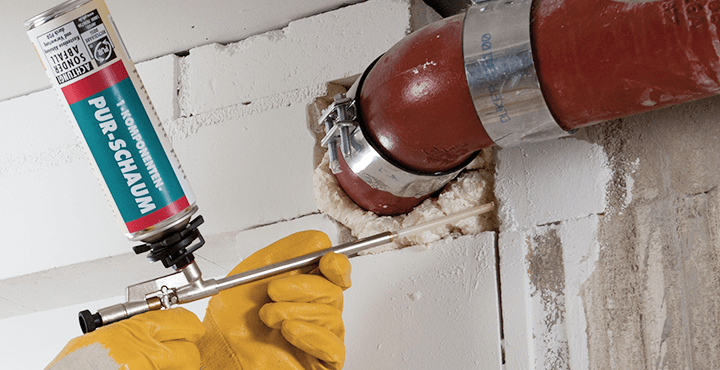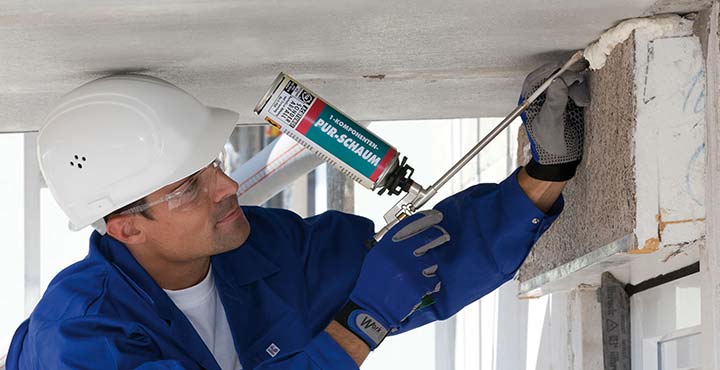
Active ingredients and health
Is there an isocyanate-free PU foam?
Are there studies about vapours from PU foam?
Do PU foams contain formaldehyde?
Do PU foams emit isocyanate vapours?
What do PU foams contain?
Are there any risks to health associated with PU foam?
Does hardened assembly foam need to be covered to avoid contact with indoor air and prevent health risks?
What do I need to take into account when working with PU foam?
Is there an isocyanate-free PU foam?
There are so-called MDI-free PU foams (MDI is the abbreviation for isocyanate). These are assembly foams that have a polyurethane structure but no more free isocyanate groups because they were turned into a non-reactive urethane structure in a previous chemical process. The foam hardening process is based on reaction-capable silane groups that, once the foam has left the can, react with the ambient moisture leading to the interconnection and therefore the hardening of the applied PU foam.
Are there studies about vapours from PU foam?
In the 1990s the Association for the Control of Emissions in Products for Flooring Installation, Adhesives and Construction Products (GEV) introduced the EMICODE to offer assurance to consumers about how to handle adhesives, sealing agents and insulating materials. This is a competition-neutral classification system that assesses the emission behaviour of products based on a strict testing procedure. PU foams that were tested were classified as very low-emission and received the best possible category EC1plus.
Do PU foams contain formaldehyde?
No. PU foams do not contain formaldehyde, neither can they create formaldehyde. Note: There is a urea-formaldehyde foam that is occasionally used in the construction field. This should not be confused with PU foams.
Do PU foams emit isocyanate vapours?
The so-called MAK value represents the maximum workplace concentration and refers to the level of diphenyl methane-4.4-diisocyanate. This value is 0.01 ppm and is not reached when the room is adequately ventilated, even if PU foams are used permanently. The Chemical Professional Association took measurements of room air in the surrounding area (10 cm away from hardened foam) and found that the isocyanate values in the air lay below the detection limit. Despite this, the safety advice on every pressurised packaging regarding the use of the foam should be observed.
What do PU foams contain?
The main constituents of PU foam are polyalcohols (polyols), isocyanates (diphenyl methane-4.4´-diisocyanate), propellants and, depending on the application area or purpose, stabilisers, accelerators and flame retardants.
Are there any risks to health associated with PU foam?
No, once the foam is hard, it has a neutral impact on the environment. Please refer to the results of the EMICODE examinations. PU foams that were tested were classified as very low-emission with the label EC1plus (= very low emission).
You will find details about the Emicode under Quality & Legal
Does hardened assembly foam need to be covered to avoid contact with indoor air and prevent health risks?
No. However, for technical reasons the foam is always covered whenever PU foam is used. For instance, when PU foam is used in its main application field, i.e. ensuring that window joints are air-tight, window insulation is stipulated to prevent draughts and heat loss. Also, purely for appearance, the PU foam should always be covered. If assembly foams are exposed to light permanently, the hardened foam will turn light to dark brown. This not only does not look nice, it makes the foam brittle. Therefore the hardened foam should be protected from UV light by a coat of paint or plaster, or by applying a sealing agent.
What do I need to take into account when working with PU foam?
Anyone working with construction foam should wear gloves and goggles. One of the greatest advantages of PU foam is its excellent adhesion properties. The effect you want on your building is something you need to avoid on your skin! Even very fresh foam is very sticky and can only be removed form the skin mechanically or with chemicals. Therefore, appropriate protective clothing should be worn to avoid accidental contact with the eyes or skin.








